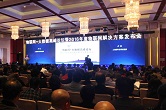Home > Attractions
Hongshan Archaeological Museum
(wndonline.gov.cn)
Updated: 2018-06-01
The Hongshan Archaeological Site, in Wuxi, is considered the cradle of Wu culture and has a tomb complex from the Spring and Autumn Period (770-256 BC) and Warring States Period (475-221 BC) along the lower reaches of the Yangtze River, which was one of China's Top 10 Archaeological Discoveries for 2004.
It is a key Historical and Cultural Site under government protection, one of the Top 100 key large archaeological projects of the 11th Five-Year Plan (2006-2010), AND a national archaeological parks as well. Its Hongshan Archaeological Museum is a 4A Tourist Attraction, at 200 Feifeng Rd, in the Wuxi New District, for showing Wu and Yue culture along the Yangtze River. Its collection of relics, unearthed from the Hongshan Tomb Complex, has various types and shapes with regional characteristics, which demonstrate the celadon techniques of the period, as well as miniature jade engraving, the burial system, and the rites and music of the Wu and Yue area during Spring and Autumn Period and Warring States Period.
The museum sits close to archaeological site and the Noble Tomb of the Qiuchengdun Archaeological Site. The exhibitions are in three parts -- the Hongshan Tomb Complex, the Qiuchengdun Noble Tomb site, and exhibitions of the history and culture of the Wu area.
Since its opening in April 2008, the museum has gotten a great deal of attention and many tourists from China and abroad who come to get a look at the culture and interesting history of China’s famous historic and cultural city of Wuxi.
The former Wuxi New District, now known as Wuxi Xinwu district or Wuxi National Hi-tech district, was founded in 1992 and underwent administrative changes in 1995, 2002 and 2005.
>> Read More
 IoT competition concludes in WND
IoT competition concludes in WND IoT industry senses an opportunity in China
IoT industry senses an opportunity in China